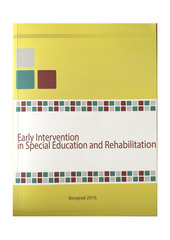Приказ основних података о документу
Bilingualism with deaf and hard of hearing preschool children
| dc.contributor | Nikolić Snežana | |
| dc.contributor | Nikić Radmila | |
| dc.contributor | Ilanković Vera | |
| dc.creator | Kovačević, Tamara | |
| dc.creator | Isaković, Ljubica | |
| dc.creator | Dimić, Nadežda | |
| dc.date.accessioned | 2021-06-17T13:17:49Z | |
| dc.date.available | 2021-06-17T13:17:49Z | |
| dc.date.issued | 2016 | |
| dc.identifier.isbn | 978-86-6203-086-3 | |
| dc.identifier.uri | http://rfasper.fasper.bg.ac.rs/handle/123456789/2424 | |
| dc.description.abstract | Bilingualism of a deaf child means the knowledge and regular use of sign language, which is used by the community of the deaf, and the spoken language, which is used by the majority who can hear. Knowing and using sign and spoken language, deaf and hard of hearing children will realize their full potential in intellectual, speech and social development. The knowledge of sign language from the earliest age helps deaf children acquaint with the world, develop their cognitive abilities, communicate with their parents and the surroundings. The creation of suitable early intervention programmes focusing on the family which offer the possibility of choice for parents and deaf and hard of hearing children is necessary. At preschool age, the task of a nursery school is to enable children to continue to learn the language which they started learning in the family (sign or spoken language). Children will learn both linguistic modalities the best though the interaction with other fluent speakers (adults and children). The aim of the research was to examine the level of knowledge of sign and spoken linguistic expression with deaf and hard of hearing preschool children within 5 lexical areas: family, food and drinks, professions, home, travels. Stimulus pictures were used in the research. The sample comprised 11 children attending preschool classes at schools for deaf and hard of hearing children. Sign language with preschool children was more developed and richer in comparison to their spoken linguistic expression. On average, deaf and hard of hearing children used more signs (gestures) than spoken words. The best results were achieved within the lexical area of Food and Drinks, while the poorest results were achieved in the area of Professions. There are great individual differences in the number of used words within different lexical areas. The deficiency in sign and spoken linguistic expression within the width of vocabulary and lexical readiness as well as within the understanding of the meaning of words was observed. The development of the entire personality of a deaf child (emotional, social and cognitive development)is to a great extent determined by auditory deprivation and difficulties in language acquisition. As a result, difficulties in using and understanding terms occur. | |
| dc.language | sr | |
| dc.publisher | University of Belgrade, Faculty of Special Education and Rehabilitation, Serbia / Univerzitet u Beogradu – Fakultet za specijalnu edukaciju i rehabilitaciju | |
| dc.relation | info:eu-repo/grantAgreement/MESTD/Basic Research (BR or ON)/179055/RS// | |
| dc.rights | openAccess | |
| dc.rights.uri | https://creativecommons.org/licenses/by-sa/4.0/ | |
| dc.source | Thematic Collection of International Importance- Early Intervention in Special Education and Rehabilitation“, Beograd, Srbija, 2016. | |
| dc.subject | bilingualism | |
| dc.subject | sign and spoken linguistic expression | |
| dc.subject | deaf and hard of hearing preschool children | |
| dc.title | Bilingualism with deaf and hard of hearing preschool children | en |
| dc.type | conferenceObject | |
| dc.rights.license | BY-SA | |
| dc.citation.epage | 360 | |
| dc.citation.other | : 347-360 | |
| dc.citation.rank | M14 | |
| dc.citation.spage | 347 | |
| dc.identifier.fulltext | http://rfasper.fasper.bg.ac.rs/bitstream/id/6288/Untitled25.pdf | |
| dc.identifier.rcub | https://hdl.handle.net/21.15107/rcub_rfasper_2424 | |
| dc.type.version | publishedVersion |


